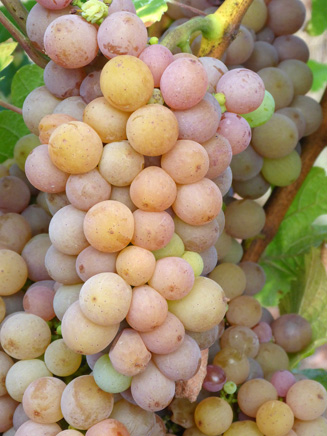
Do you get your Pinots mixed up? I mean, do you know the difference between a Pinot Blanc and a Pinot Gris? If the whole thing seems a bit confusing fret not, for you are almost certainly not alone. Although there are countless grapes with the word “pinot” in the name, only four of them are important so it’s not much of a challenge to sort them out. The first written record of “pinot” appears in 1375 and so we can be pretty sure that the grape was around for a good many years before that. It’s thought that the name probably comes from the fact that the small, tightly-packed grape clusters resemble pine cones.
The most famous of the four is undoubtedly the “black pinot”, Pinot Noir (PEE-noh NWAH), a red grape that produces light-bodied and fruity wine. Pinot Noir finds its finest expression in its home region of Burgundy, where it produces some of the finest and most expensive reds in the world. It’s grown in many countries including Australia and New Zealand and it’s also used in the making of Champagne. Pinot Noir can be tricky to cultivate and the yields are rather low, which is why the wine is more expensive than many other varietals.
The second most important is the white “Pinot Gris” (PEE-noh GREE) known in Italy as in Pinot Grigio (PEE-noh GREE-joh). Pinot Gris from the Alsace region of France makes superb, spicy full-bodied wines. The Italian version has a clean profile of apple and pear with a rather bitter finish.
The two remaining and lesser-known types are Pinot Blanc, found mainly in France and the dark red Pinot Meunier (“Miller’s Pinot”) which although little known, is one of the most widely-planted grapes in France. This is because it’s used in the making of Champagne though it’s rarely seen as a stand-alone varietal.
You may be wondering whether these “pinot” grapes are related to each other in some way. Yes, they are. They are the same variety (or “cultivar” to be more technically accurate) and because this variety is so old, it’s had plenty of time to naturally mutate into new clones. The word “clone” comes from the Greek word for “twig” and refers to the age-old practice of propagating new vines by taking cuttings and grafting.
Some years ago, a friend whose knowledge of viticulture is more extensive than mine, told me that Californian oenologists had cloned a new Pinot variety designed to help those with the condition known colloquially as a “weak bladder.” The new grape variety, he solemnly informed me, was called “Pinot Mohr”. Several moments elapsed before the penny dropped.
Canti Pinot Grigio delle Venezie DOC 2018 (white), Italy. Bt 499 @ Villa Market
This wine from the Veneto region, which of course takes its name from the city of Venice and it lies in the north-east corner of the country. The wine is made by the respected firm of Canti, one of the more recent players on the Italian wine scene. In many ways, this is fairly typical example; a pale straw yellow with hints of green; an attractive aroma with the classic varietal qualities. I enjoyed the clean citrus tang along with distinctive hints of grapefruit or pomelo. The aromas are quite restrained which is a quality I appreciate. The aroma of some Australian whites is the equivalent of being hit in the face with a sack of pineapples.
The wine is dry, assertive and sharply focused with reminders of green apple and citrus. It’s also quite rich in acidity too, so if you prefer your whites a little less authoritative, just pour it into a decanter and let it rest for an hour in the fridge. You might be surprised what a difference the air makes, for it softens the profile considerably. At 12% ABW this wine would make an attractive aperitif but I’d prefer it as a food wine, especially with fish or pasta served in a delicate creamy sauce.
Salisbury “1848” Pinot Grigio 2018 (white), Australia. Bt 399 @ Friendship
The year 1848 refers to the year in which John Harvey, a settler from Scotland acquired land in South Australia. He named the tiny settlement after the English cathedral city and it became one of the original vineyards in the Murray Darling region.
This is a typical Australian Pinot Grigio; a pale gold which fades to transparent where the liquid meets the glass, confirming that the wine is young and light bodied. There’s a lovely welcoming aroma; that typical “tropical fruit” smell usually associated with Chardonnay and a honeyed herby aroma in the background. On the aroma alone you’d be forgiven for thinking that it’s a Chardonnay. But the colour and taste tells us otherwise. And so does the label, for that matter.
At just 12.4% ABV the wine is light, dry, crisp and refreshing with a well-defined citrus taste. There’s a satisfying tang of acidity on the palate and a clean, dry finish. Although an entry-level wine, it’s well-crafted and would be perfect for light fish dishes. It would also contrast pleasingly with chicken fillets. After the bottle has been opened for about twenty minutes and the wine has received a good dollop of oxygen, the acidity softens considerably. It makes a pleasing stand-alone drink and during the evening I finished the bottle with the help of the dogs. I really must buy some more. Wine, I mean, not dogs.





